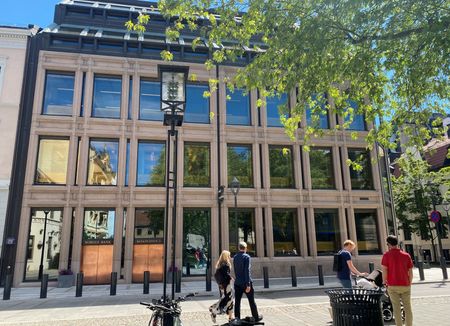By Victoria Klesty
OSLO (Reuters) -Norway’s central bank raised its key policy rate by 50 basis points (bps) to a 15-year high of 3.75% on Thursday in a bid to curb inflation, and said it aimed for another hike in August, predicting the rate would rise to 4.25% during the autumn.
The increase was bigger than expected. Of the 32 economists polled by Reuters, 24 had forecast an increase of 25 bps, while eight correctly anticipated an rise of 50 bps.
“If we do not raise the policy rate, prices and wages could continue to rise rapidly and inflation become entrenched,” Norges Bank Governor Ida Wolden Bache said in a statement.
Norway’s core inflation rose to 6.7% in May, the highest on record and above the central bank’s forecast of 6.0%.
The Norwegian currency, the crown, surged to 11.56 against the euro at 0913 GMT from 11.69 just before the announcement.
“A higher policy rate than previously signalled is needed to bring inflation down to target,” Norges Bank said, while warning that the policy rate might have to go higher than project “if the crown turns out to be weaker than assumed or pressures in the economy persist.”
At the same time, the effects of past rate hikes are not yet fully evident in the economy, Norges Bank added.
“If inflation declines more rapidly or there is a more pronounced slowdown in the Norwegian economy, the policy rate may be lower than currently envisaged,” it said.
In May, Norges Bank had said it would “most likely” hike again in June, and official data has since shown higher-than-expected growth in consumer prices and a brighter outlook for many Norwegian companies.
“Today’s hawkish decision shows that Norges Bank means business and is concerned about inflation becoming entrenched,” analysts at Nordea said in a note to clients.
“The decision is justified given that inflation has come in markedly higher than anticipated,” Nordea added.
The hike raises the policy rate to its highest level since the outbreak of the global financial crisis of 2008.
While Norway in 2021 was among the first Western nations to hike rates after the pandemic, its speed of tightening has been slower than in the neighbouring eurozone, hitting the currency.
The Norwegian crown has weakened by 8% this year on a trade weighted basis, fuelling inflation, and some analysts had said that a 50 bps hike could help shore up the currency, while a 25 bps increase was less likely to do so.
The European Central Bank last week raised its key policy rate and is expected to hike again, while the U.S. Federal Reserve left the cost of borrowing on hold, but signalled that its campaign of tightening will resume.
(Reporting by Victoria Klesty, editing by Terje Solsvik & Simon Cameron-Moore)





